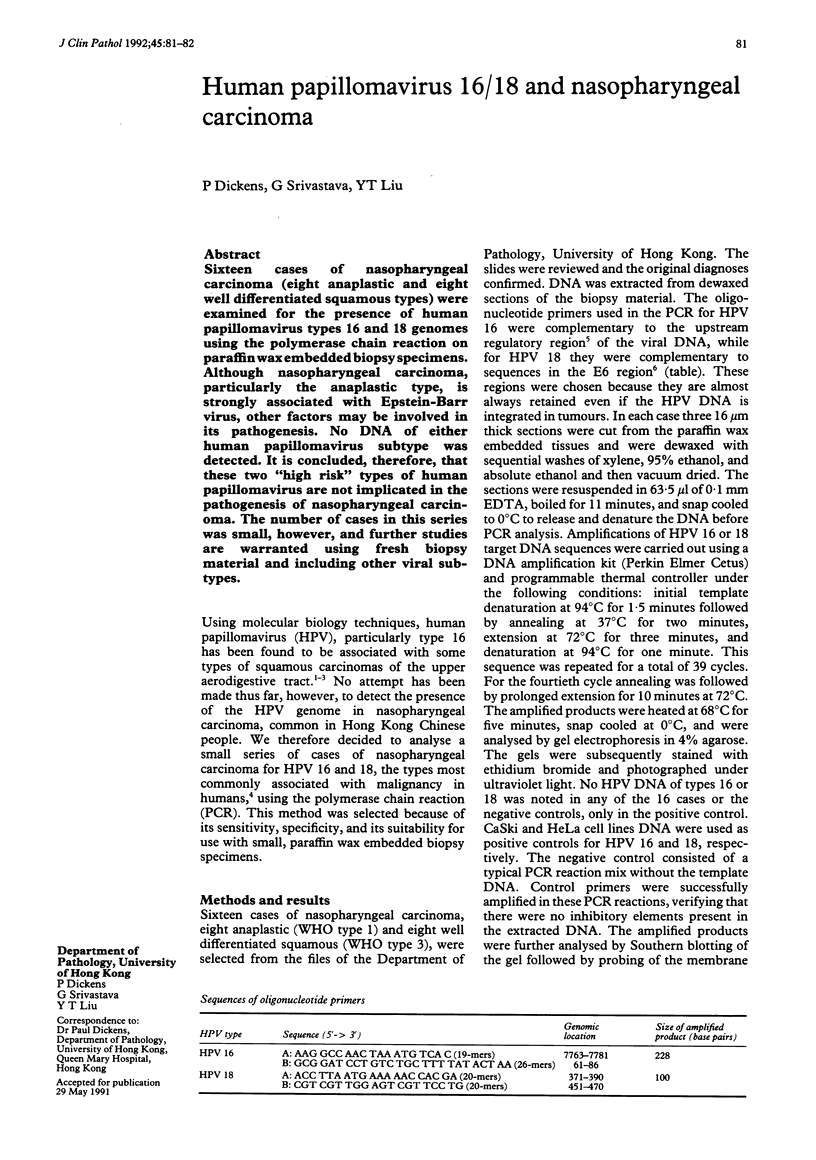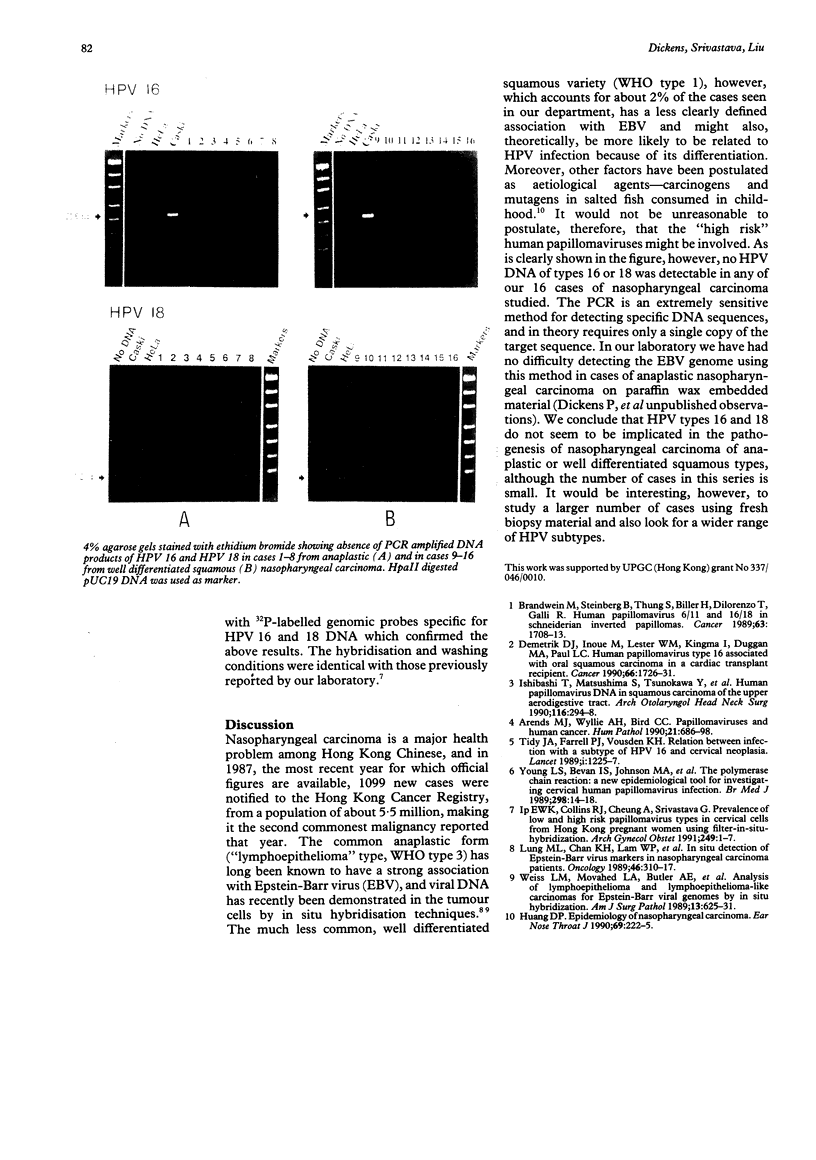Abstract
Sixteen cases of nasopharyngeal carcinoma (eight anaplastic and eight well differentiated squamous types) were examined for the presence of human papillomavirus types 16 and 18 genomes using the polymerase chain reaction on paraffin wax embedded biopsy specimens. Although nasopharyngeal carcinoma, particularly the anaplastic type, is strongly associated with Epstein-Barr virus, other factors may be involved in its pathogenesis. No DNA of either human papillomavirus subtype was detected. It is concluded, therefore, that these two "high risk" types of human papillomavirus are not implicated in the pathogenesis of nasopharyngeal carcinoma. The number of cases in this series was small, however, and further studies are warranted using fresh biopsy material and including other viral subtypes.
Full text
PDF

Images in this article
Selected References
These references are in PubMed. This may not be the complete list of references from this article.
- Arends M. J., Wyllie A. H., Bird C. C. Papillomaviruses and human cancer. Hum Pathol. 1990 Jul;21(7):686–698. doi: 10.1016/0046-8177(90)90027-3. [DOI] [PubMed] [Google Scholar]
- Brandwein M., Steinberg B., Thung S., Biller H., Dilorenzo T., Galli R. Human papillomavirus 6/11 and 16/18 in Schneiderian inverted papillomas. In situ hybridization with human papillomavirus RNA probes. Cancer. 1989 May 1;63(9):1708–1713. doi: 10.1002/1097-0142(19900501)63:9<1708::aid-cncr2820630911>3.0.co;2-9. [DOI] [PubMed] [Google Scholar]
- Demetrick D. J., Inoue M., Lester W. M., Kingma I., Duggan M. A., Paul L. C. Human papillomavirus type 16 associated with oral squamous carcinoma in a cardiac transplant recipient. Cancer. 1990 Oct 15;66(8):1726–1731. doi: 10.1002/1097-0142(19901015)66:8<1726::aid-cncr2820660814>3.0.co;2-y. [DOI] [PubMed] [Google Scholar]
- Huang D. P. Epidemiology of nasopharyngeal carcinoma. Ear Nose Throat J. 1990 Apr;69(4):222–225. [PubMed] [Google Scholar]
- Ip E. W., Collins R. J., Cheung A. N., Srivastava G. Prevalence of low and high risk human papillomavirus types in cervical cells from Hong Kong pregnant Chinese using filter in situ hybridization. Arch Gynecol Obstet. 1991;249(1):1–7. doi: 10.1007/BF02390700. [DOI] [PubMed] [Google Scholar]
- Ishibashi T., Matsushima S., Tsunokawa Y., Asai M., Nomura Y., Sugimura T., Terada M. Human papillomavirus DNA in squamous cell carcinoma of the upper aerodigestive tract. Arch Otolaryngol Head Neck Surg. 1990 Mar;116(3):294–298. doi: 10.1001/archotol.1990.01870030058009. [DOI] [PubMed] [Google Scholar]
- Lung M. L., Chan K. H., Lam W. P., Kou S. K., Choy D., Chan C. W., Ng M. H. In situ detection of Epstein-Barr virus markers in nasopharyngeal carcinoma patients. Oncology. 1989;46(5):310–317. doi: 10.1159/000226739. [DOI] [PubMed] [Google Scholar]
- Tidy J. A., Vousden K. H., Farrell P. J. Relation between infection with a subtype of HPV16 and cervical neoplasia. Lancet. 1989 Jun 3;1(8649):1225–1227. doi: 10.1016/s0140-6736(89)92329-5. [DOI] [PubMed] [Google Scholar]
- Weiss L. M., Movahed L. A., Butler A. E., Swanson S. A., Frierson H. F., Jr, Cooper P. H., Colby T. V., Mills S. E. Analysis of lymphoepithelioma and lymphoepithelioma-like carcinomas for Epstein-Barr viral genomes by in situ hybridization. Am J Surg Pathol. 1989 Aug;13(8):625–631. doi: 10.1097/00000478-198908000-00001. [DOI] [PubMed] [Google Scholar]
- Young L. S., Bevan I. S., Johnson M. A., Blomfield P. I., Bromidge T., Maitland N. J., Woodman C. B. The polymerase chain reaction: a new epidemiological tool for investigating cervical human papillomavirus infection. BMJ. 1989 Jan 7;298(6665):14–18. doi: 10.1136/bmj.298.6665.14. [DOI] [PMC free article] [PubMed] [Google Scholar]



